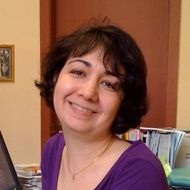HSE ISSEK Report Is the Most-cited Publication in the Digital Field

Issued in 2019 by the Institute for Statistical Studies and Economics of Knowledge (ISSEK) at HSE University, the report ‘What is the Digital Economy?’ has topped the Russian Science Citation Index list of the 6,000 most-cited publications in the digital field in 2019–2021. Analysis of the database shows that other ISSEK papers on digital topics have also become hits in the research world.
The report has been cited about 900 times in the little over 900 days since it was published. This popularity in the expert community can be explained by the diversity of the topics examined, many of which appear in Russian-language scientific literature for the first time. The report discusses timely issues related to trends in digital technologies, state support practices, and original approaches to the statistical measurement of the digital economy and its effects.

Pavel Rudnik
‘In our research practice, we are often confronted with different approaches to defining and studying complex phenomena in the field of technological development. There is often a lack of works that summarise different points of view and provide the broadest possible overview of assessments and cases. The report 'What is the Digital Economy?' is the first Russian effort to give a holistic panorama of the development of this phenomenon and models for its analysis. I am very glad that it has resonated with readers, particularly professionals engaged in the study of this agenda,' says Pavel Rudnik, HSE ISSEK Deputy Director.
The same year, 2019, saw the launch of the Digital Economy national programme in Russia. Since then, the role of digitalization has become increasingly important. A Strategy and Code of Ethics for Artificial Intelligence have been developed, agreements have been signed between the Russian government and major companies to develop high-tech areas, seven federal projects have been adopted, and numerous digital technology projects are being implemented at both the government and corporate levels. All of this encourages ISSEK researchers to expand the scope of studies into the digital economy. In 2021, a new report ‘Digital Transformation of Industries: Starting Conditions and Priorities’ was published for the April Conference of HSE University. The results of systematic monitoring are regularly published in issues of the ‘Digital Economy’ and ‘iFORA-express’ series. For five years, ISSEK and the .RU/.RF Coordination Centre have published an annual series of analytical reports on trends in the global network. This series will soon be supplemented by a new book.

Konstantin Vishnevskiy
Konstantin Vishnevskiy, Director of the Digital Economy Research Centre, highlights the infographic report ‘Digital Technologies in the Russian Economy’, which was prepared using the iFORA big data intelligent analysis system. ‘When we were writing the report, we relied on the analysis of millions of scientific articles, patents, market reviews, industry periodicals, and other sources. The assessments of scientific research in Russia and the overview of global trends in digital technologies presented in the report provide a comprehensive analysis of the possibilities of the application of digital solutions in various social and economic sectors. The accessible infographic format makes this report more attractive to the general public. I hope it will be of interest to the digital community not only in Russia, but in other countries too.’
The Russian Science Citation Index shows that other ISSEK digital-related works have been hits in the research world. Apart from the report ‘What is the Digital Economy?’ two statistical collections—‘Digital Economy Indicators: 2019’ and ‘Digital Economy: 2019’—are in the top-3 most frequently cited papers (492 and 291 citations since 2019, respectively). These are two annual series of statistical collections on the digital economy published by ISSEK in cooperation with the Ministry of Digital Development of Russia and Rosstat.

Gulnara Abdrakhmanova
Gulnara Abdrakhmanova, Director of the Centre for Statistics and Monitoring of Information Society, ISSEK, says, ‘In our collections, you will find statistical information on virtually every aspect of the digital economy in Russia and its regions. Our analyses describe how digital technologies are created and used, explain how people can access the digital environment, and outline the effects of digitalization and the resources of the digital economy. We have been publishing these collections for over a decade now. Over this time, we have significantly expanded the range of indicators we analyse and publish. This is partly due to the continuously improving federal statistical observation programme and the use of various data sources. When preparing the collections, the authors calculate indicators based on data from Rosstat, the Russian Ministry of Digital Development, the Russian Federal Customs Service, the Bank of Russia, the Russian Ministries of Science and Education, State Medical and Social Care Assessments, Eurostat, OECD, etc. The key target audiences of statistical collections include government decision-makers, businesses, researchers, students, schoolchildren, and journalists, but they are also available to a wide range of readers.’

